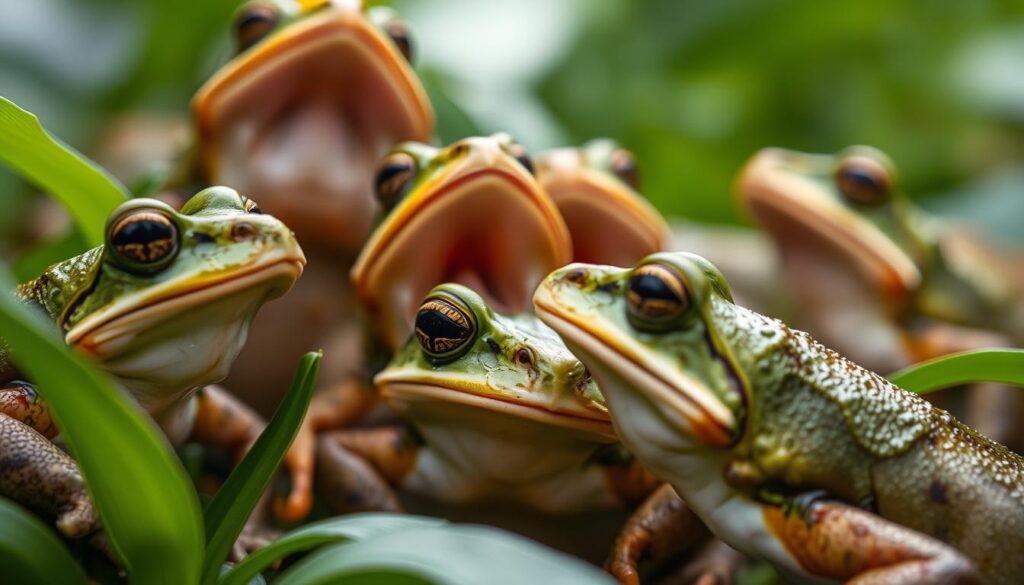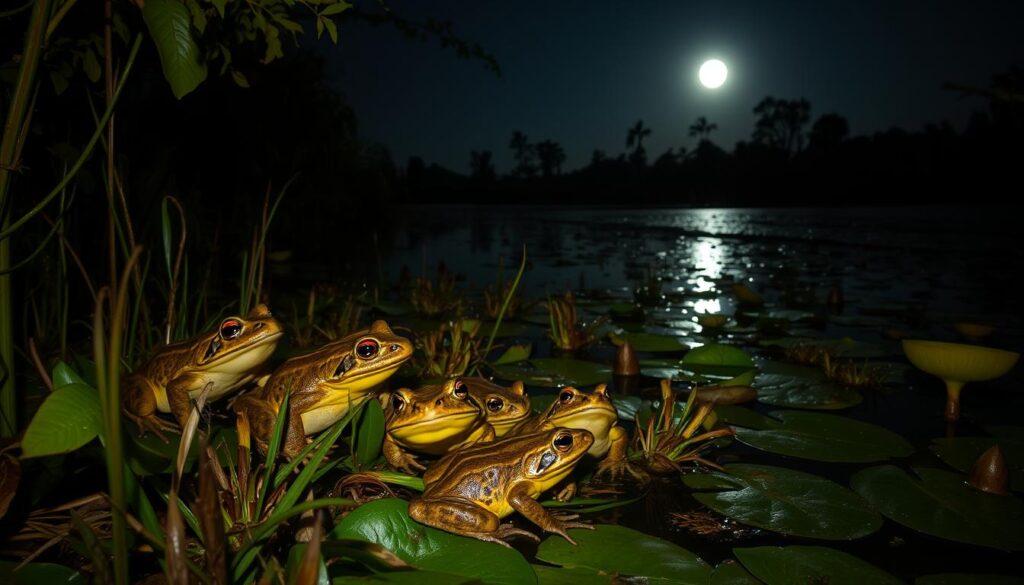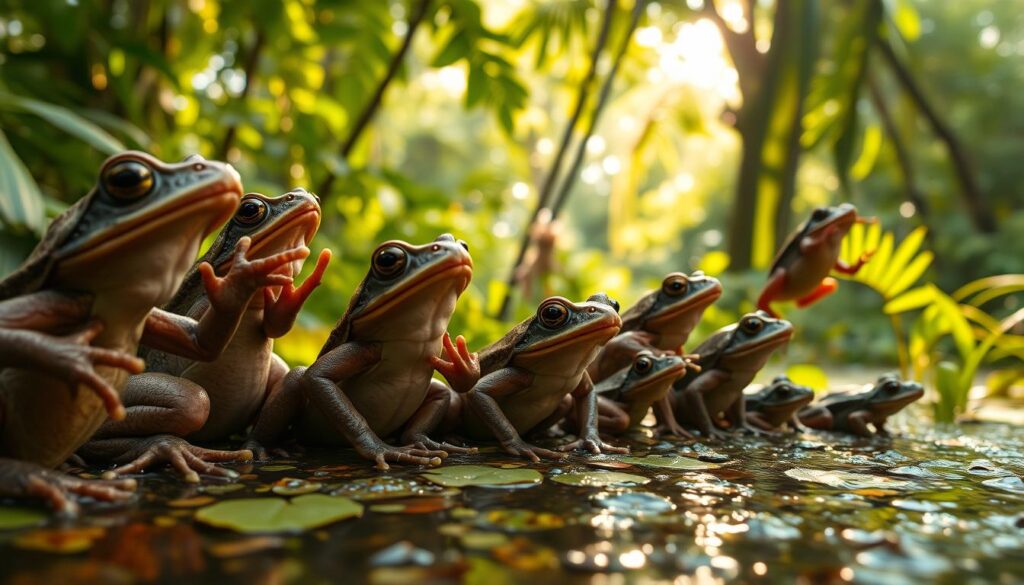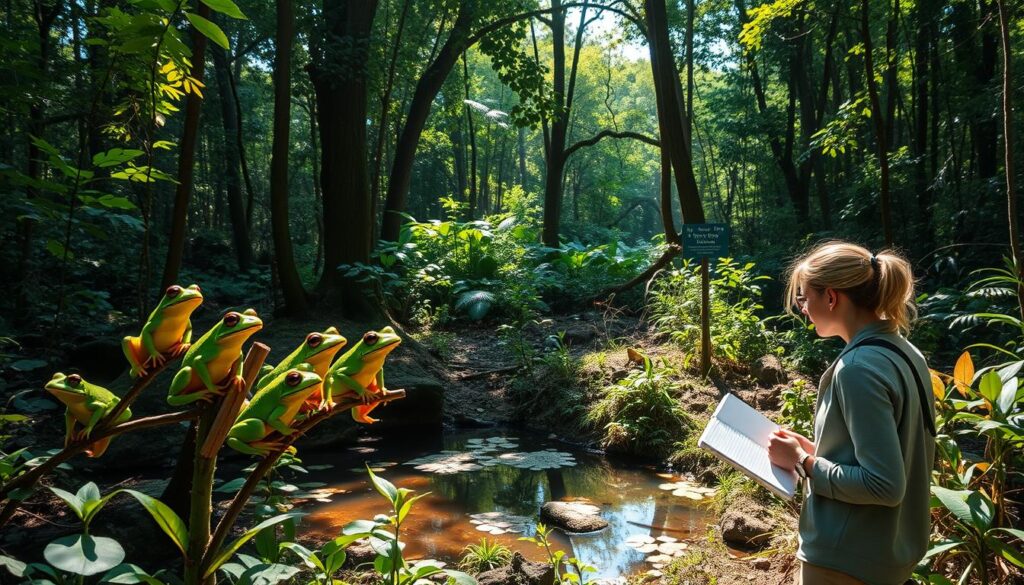Did you know that some frogs can produce over 20 distinct calls? These amphibians rely on a mix of auditory and visual signals to interact with their surroundings. Their communication systems are surprisingly complex, especially in diverse habitats like rainforests and wetlands.
In noisy environments, such as breeding choruses, frogs face a challenge similar to humans at a crowded party. This is often referred to as the “cocktail party problem.” Despite overlapping calls, they manage to distinguish between mating invitations and territorial warnings.
Evolution has equipped these animals with unique adaptations. For example, some species have developed specialized vocal sacs to amplify their sounds. Others use visual cues like body movements to convey messages.
Conservation efforts play a vital role in protecting the acoustic habitats essential for their survival. Without these environments, the intricate communication networks of frogs could be lost forever.
Key Takeaways
- Frogs use a combination of sounds and visual signals to communicate.
- They face challenges like the “cocktail party problem” in noisy habitats.
- Evolutionary adaptations help them thrive in diverse environments.
- Specialized vocal sacs and body movements enhance their communication.
- Conservation is crucial to protect their acoustic habitats.
Introduction to Frog Communication
For frogs, sound is more than just noise—it’s a survival tool. These amphibians have evolved acoustic communication as their primary method for social interaction. Males use distinct calls to advertise their fitness and location, with variations in pitch and rhythm unique to each species.
Environmental factors like humidity and temperature play a significant role in modulating their vocal activity. For example, higher humidity often enhances sound transmission, making it easier for calls to travel farther. This adaptation ensures their messages are heard even in dense habitats.
In crowded breeding choruses, frogs face a challenge known as “auditory scene analysis.” This ability allows them to isolate individual calls amidst the noise, much like humans focusing on a single voice in a busy room. This skill is crucial for distinguishing between mating invitations and territorial warnings.
The diversity of frog calls is a testament to their biodiversity. With over 4,800 species globally, each has developed unique vocal patterns. This variety not only aids in communication but also reflects the richness of their ecosystems.
To better understand their calls, consider the Milwaukee Train Horn analogy. Just as a train horn uses loud, structured sounds to cut through noise, frogs rely on distinct calls to stand out in their environments. This comparison highlights the efficiency of their acoustic strategies.
The Role of Vocalizations in Frog Communication
Male frogs rely heavily on vocalizations to establish their presence in the wild. These calls serve multiple purposes, from attracting mates to defending territories. Each species has developed unique patterns to ensure their messages are heard clearly.

There are three primary types of calls: advertisement, aggressive, and distress. Advertisement calls are used by males to attract females, showcasing their fitness and location. Aggressive calls warn rivals to stay away, while distress calls signal danger to others.
The process of sound production is fascinating. Air from the lungs passes through the larynx, causing the vocal cords to vibrate. These vibrations resonate in the vocal sacs, amplifying the sound. This biomechanical process allows even smaller frogs to produce loud calls, though it requires significant energy.
Studies show that females often prefer lower-frequency calls, which are linked to larger males. This preference highlights the role of vocalizations in mate selection. By understanding these patterns, researchers gain insights into the complex communication systems of these remarkable animals.
How Frogs Communicate: Sounds and Signals
Rainfall and noise pollution significantly impact frog vocalizations. These amphibians rely on auditory signals to navigate their environments, from dense forests to urban areas. Their ability to adapt to changing conditions is a testament to their resilience.
Auditory Signals in Frog Communication
Frogs use their tympanums and bone conduction to localize sounds. This adaptation helps them distinguish between mating calls and territorial warnings. For example, Cope’s gray treefrogs achieve a 4-6 dB masking release, allowing them to isolate individual calls in noisy choruses.

Studies show that frogs prioritize low-frequency signals in windy conditions. This behavior ensures their messages are heard clearly, even in challenging environments. Their ability to adapt call timing and frequency highlights their sophisticated communication strategies.
Environmental Influences on Frog Calls
Rainfall amplifies frog calls and often triggers breeding activity. This natural phenomenon enhances sound transmission, making it easier for males to attract females. However, human-induced noise pollution, such as traffic, disrupts these interactions.
Frogs exhibit adaptive behaviors to cope with noise. For instance, some species adjust their call timing or frequency to stand out in noisy habitats. These adaptations ensure their survival in increasingly urbanized environments.
“The ability of frogs to adapt their calls in response to environmental changes is a remarkable example of evolutionary resilience.”
For more insights into frog hearing and communication, visit this detailed resource. Additionally, if you’re interested in locating frogs in the wild, check out these helpful tips.
The Science Behind Frog Hearing
Understanding frog hearing reveals fascinating adaptations in these amphibians. Their ability to detect and interpret sound is crucial for survival, especially in noisy environments. Let’s explore the anatomy and mechanisms that make their hearing so unique.

Anatomy of a Frog’s Ear
A frog’s ear consists of three main parts: the tympanum, columella bone, and inner ear structures. The tympanum, or eardrum, varies in size among species. For example, males in six North American species have larger eardrums to detect female chirps more effectively.
Lung vibrations also play a role in hearing. These vibrations help detect high-frequency sounds, enhancing their ability to localize calls. This adaptation is particularly useful in dense habitats where sound clarity is essential.
How Frogs Localize Sounds
Frogs excel at detecting low frequencies, typically below 3 kHz. This range contrasts with human hearing, which spans a broader spectrum. Their auditory system is finely tuned to isolate specific calls, even in noisy environments.
One remarkable example is the Gardiner’s frog, which “hears” through mouth cavity vibrations. This unique method bypasses traditional ear structures, showcasing the diversity of auditory adaptations in frogs.
Neuroethological studies on leopard frogs reveal their ability to localize sound spatially. This skill helps them distinguish between mating calls and territorial warnings, ensuring effective communication.
“The auditory system of frogs is a testament to their evolutionary resilience and adaptability.”
- The tympanum size varies by sex, aiding in sound detection.
- Lung vibrations enhance high-frequency hearing.
- Frogs excel at low frequencies, unlike humans.
- Gardiner’s frog uses mouth vibrations for hearing.
- Leopard frogs demonstrate advanced spatial sound localization.
Frog Communication in Noisy Environments
In the wild, frogs face a unique challenge: making their voices heard in noisy environments. From bustling breeding choruses to urban soundscapes, these amphibians have developed remarkable strategies to ensure their signals are not lost in the din.

Strategies for Overcoming Noise
One key tactic is spatial release from masking. This allows females to detect calls 3-6 dB better when signals and noise are separated. For example, female Cope’s gray treefrogs require 6-9 consecutive call pulses during noise dips for recognition.
Evolution has also equipped frogs with other tools. Synchronized choruses, call redundancy, and amplitude modulation help them stand out in crowded environments. These adaptations ensure their messages are clear, even when surrounded by competing sounds.
The Cocktail Party Problem in Frogs
The “cocktail party problem” refers to the difficulty of isolating individual calls in a chorus. Just like humans at a loud party, frogs must filter out background noise to focus on relevant signals. Their auditory grouping strategies are surprisingly similar to human speech perception.
Studies show that frogs prioritize low-frequency calls in windy conditions. This behavior enhances their ability to communicate effectively, even in challenging environments.
“The ability of frogs to adapt their calls in response to environmental changes is a remarkable example of evolutionary resilience.”
Citizen science projects are now leveraging acoustic recordings to monitor frog populations. These initiatives provide valuable insights into their communication strategies and help track changes in their habitats. For more on why frogs are most vocal at night, check out this resource on night-time croaking.
Evolutionary Aspects of Frog Communication
Evolution has shaped the way frogs interact with their environment in fascinating ways. Over millions of years, these amphibians have developed unique communication methods to survive and thrive. Their calls and signals are not just sounds but tools for survival, shaped by natural selection and environmental pressures.

Adaptations in Frog Calls
One of the most remarkable adaptations is the development of harmonic call structures. For example, bullfrogs and treefrogs evolved these structures independently, a phenomenon known as convergent adaptation. This suggests that similar environmental challenges led to parallel solutions.
Call complexity also plays a role in speciation. Acoustic divergence helps reduce hybridization between closely related species. Fossil evidence shows that early frog vocal structures were simpler, highlighting how calls have evolved over time.
Predation pressure has further shaped these adaptations. Many species call at night to avoid predators, a behavior that has become a key survival strategy. The túngara frog, for instance, balances mate attraction and bat detection with its whine-chuck call sequence.
The Role of Communication in Frog Evolution
Communication has been a driving force in the evolution of frogs. Phylogenetic studies reveal that call diversity peaks in tropical species, where competition for mates is intense. This diversity reflects the richness of their ecosystems and the complexity of their social interactions.
Key evolutionary adaptations include:
- Acoustic divergence to reduce hybridization.
- Nocturnal calling behavior to avoid predators.
- Complex call sequences to attract mates while minimizing risks.
“The evolution of frog communication is a testament to their adaptability and resilience in diverse environments.”
Understanding these evolutionary aspects provides valuable insights into the survival strategies of these remarkable amphibians. Their ability to adapt their calls and signals continues to fascinate researchers and conservationists alike.
Frog Communication and Conservation
The survival of frog populations depends on effective communication and habitat preservation. These amphibians rely on their unique calls to navigate their environments, but human activities threaten their ability to thrive. Conservation efforts are essential to protect their delicate ecosystems.

Monitoring Frog Populations Through Calls
Bioacoustic surveys have emerged as a non-invasive tool to assess frog populations. By recording and analyzing their calls, researchers can track population health and detect early signs of ecological distress. Silent choruses often indicate environmental issues, such as habitat degradation or pollution.
These surveys provide valuable data for conservation strategies. For example, the California red-legged frog has seen population recovery due to targeted efforts based on acoustic monitoring. This success highlights the importance of using technology to protect vulnerable species.
The Importance of Protecting Frog Habitats
Habitat loss is a major threat to frog populations. Wetlands, essential for breeding, are often drained for urban development. This eliminates critical habitats and disrupts their communication networks.
Noise-reduction zones near critical areas can mitigate human impact. Reducing traffic and industrial noise allows frogs to communicate effectively, ensuring their survival. Community engagement, through apps like FrogID, also plays a vital role in monitoring and protecting these amphibians.
“Protecting frog habitats is not just about saving a species—it’s about preserving the balance of entire ecosystems.”
- Bioacoustic surveys track population health non-invasively.
- Habitat loss, especially in wetlands, threatens breeding sites.
- Noise-reduction zones help frogs communicate in urban areas.
- Community apps like FrogID promote citizen science and awareness.
Conclusion
The intricate world of frog communication highlights nature’s ingenuity. These amphibians have evolved remarkable adaptations, from harmonic calls to spatial sound localization, ensuring their survival in diverse environments. Their signals are not just sounds but vital tools for mating, territory defense, and survival.
However, climate change and pollution threaten their habitats. Protecting wetlands and reducing noise pollution are critical steps to safeguard their communication networks. Public participation in monitoring programs, like bioacoustic surveys, can make a significant difference.
Healthy frog populations reflect balanced ecosystems. By preserving their habitats, we protect Earth’s acoustic biodiversity. Every effort counts in ensuring these remarkable species continue to thrive.
FAQ
What are the main types of calls used by male frogs?
How do environmental factors affect frog communication?
Why do frogs form choruses during breeding season?
How do frogs localize sounds in their environment?
What adaptations help frogs communicate in noisy areas?
How does communication play a role in frog evolution?
Why is monitoring frog calls important for conservation?
What challenges do frogs face in noisy environments?

I’m Lena Adams—a product of an unconventional upbringing in the African wilderness. My father, a daring explorer of African wildlife, sparked my fascination with reptiles, a passion that intertwined with the tragic loss of my mother during an expedition, leaving an indelible mark on my life. Driven to understand the creatures that captivated my parents, I embarked on my journey, sharing insights about reptiles, frogs, and lizards on my website. Through my explorations and conservation efforts, I honour my family’s legacy while seeking connections—to the creatures, nature, and the mother whose presence I yearn to understand.
